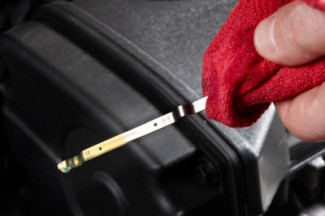Accurate warning lights and the improved reliability of the modern car mean that checking under the bonnet has become a less frequent pastime for drivers. However, most manufacturers agree that you should regularly check oil and water levels.
The modern engine might also look a bit different from the cars we used to drive, but the basics are the same. Open the bonnet and you’ll find the engine’s oil dipsticks are clearly marked with a bright plastic covering. Once you know where it’s positioned, the check becomes as simple as on your old car from the ’80s or ’90s!
Become familiar with your car’s owner’s handbook. With more and more cars requiring specific lubricants and fluids, it’s the best way to ensure that you put the correct spec oil in your car. The same goes for coolant and brake fluid. To parrot an oil company’s ad campaign from years ago: “Oils ain’t oils, Sol.”

Oil checks are simple and quick. Wait for a few minutes after you turn the engine off, and park on a level piece of roadway for the oil to settle. Before you remove the dipstick, make sure you look closely at its entry point into the engine – or you may not be able to reinsert it – and then wipe with a clean cloth or paper towel. Marked towards the lower end are the high- and low-level markings, and the engine oil should always be between these two points. Insert the dipstick back into the tube and then remove to see where the level has registered. If it’s not between the points, add the correct specification oil via the engine oil filler cap located on the top of the engine.
Checking the coolant level is just as simple. The easiest way is to check the plastic reserve tank that’s connected to the cooling system. On the side of the reservoir will be a low and high mark and the coolant level should be between the two marks. It’s always good practice to check the coolant level on the radiator via the radiator cap, with one important proviso – this should always be done when the engine is cold. Removing the cap when the engine is hot can cause coolant to spray out under pressure, seriously scalding you. If the level is low you can add coolant, again checking the owner’s handbook for the correct recommendation.
You should also check your brake fluid level regularly. Normally located at the back or side of the engine bay, the brake fluid reservoir is usually made of plastic with a high and low marking on the side. Normally the fluid will sit between these graduations, and vary slightly as the brake pads wear. If the level is continuously low and dropping there could be a leak in the braking system that requires immediate mechanical attention.
Don’t rely on the car’s warning indicator lamps. A few minutes checking under the bonnet could save you a lot of grief!
Source: Mynrma
